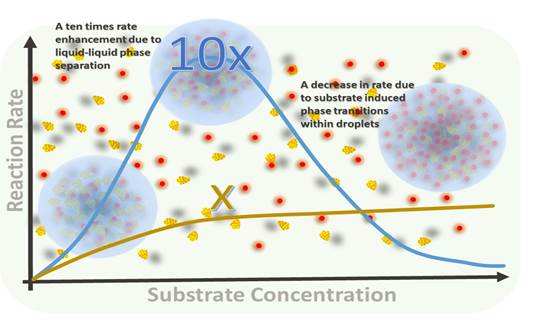
How Are Catalytic Droplets revolutionizing chemical reactions?
Researchers at the Institute of Nano Science and Technology (INST), Mohali, have developed catalytic droplets that increase the speed and efficiency of chemical reactions by tenfold. This innovation promises faster drug development, quicker access to new medications, and reduced healthcare costs. But how exactly are these catalytic droplets changing the game, and what makes them so revolutionary?
What Are the limitations of traditional catalysis?
Traditionally, chemists have used physical and chemical barriers to control molecules during catalytic reactions. While these barriers effectively maintain molecular structure, they also restrict the movement of substrates (reacting molecules) and products (resulting molecules). This limitation often slows down the very reactions they aim to facilitate, particularly in critical fields like drug development.
How do barrier-free Catalytic Droplets work?
Seeking to overcome these limitations, Professor Sarmistha Sinha and her team at INST devised a new approach—barrier-free catalytic droplets. They confined protein–metal nanocomposites within droplets formed through liquid–liquid phase separation instead of traditional barriers.
In this innovative method, the molecules within the droplets are free to move, enhancing the catalytic efficiency of metal nanocatalysts by a staggering tenfold. This breakthrough represents a significant leap forward, making chemical reactions faster and more efficient than ever before.
What happens inside these Catalytic Droplets?
INST researchers conducted further studies to investigate how different conditions impact the behavior of these catalytic droplets. They found that at higher substrate concentrations, the once-fluid droplets underwent an internal phase transition, restricting the movement of both the substrate and the products. This slowed the overall reaction rate, highlighting the importance of managing substrate concentrations during catalysis.
What could this mean for industrial processes?
The findings, published in the journal Nanoscale, could transform how industries approach chemical reactions. The ability to confine molecules in barrier-free droplets while maintaining or amplifying reaction rates could revolutionize sectors like drug manufacturing and energy production. Faster reactions could lead to quicker medication development, benefitting patients and potentially lowering healthcare costs.
What are the potential applications of Catalytic Droplets?
The implications of this research go beyond faster drug development. Understanding phase transitions within catalytic droplets could pave the way for new technologies that exploit liquid–liquid phase separation for enhanced industrial processes. Whether in energy production or other sectors, this discovery has the potential to make processes more efficient and cost-effective.
Conclusion: are Catalytic Droplets the future of catalysis?
Catalytic droplets developed by INST Mohali offer a new paradigm in chemical reactions, providing unprecedented speed and efficiency. By eliminating traditional barriers and enabling free molecular movement within droplets, this breakthrough holds immense potential for various industries. From accelerating drug development to optimizing energy production, catalytic droplets may very well be the future of catalysis and innovation.
कैटेलिटिक ड्रॉपलेट्स रासायनिक प्रतिक्रियाओं में क्रांति कैसे ला रहे हैं?
मोहाली के इंस्टीट्यूट ऑफ नैनो साइंस एंड टेक्नोलॉजी (INST) के वैज्ञानिकों ने कैटेलिटिक ड्रॉपलेट्स विकसित किए हैं, जो रासायनिक प्रतिक्रियाओं की गति और दक्षता को दस गुना बढ़ा देते हैं। यह नवाचार दवाओं के विकास में तेजी, नई दवाओं तक शीघ्र पहुंच और स्वास्थ्य देखभाल लागत को कम करने की क्षमता रखता है। लेकिन ये कैटेलिटिक ड्रॉपलेट्स वास्तव में कैसे काम करते हैं, और इन्हें इतना क्रांतिकारी क्या बनाता है?
पारंपरिक कैटेलिसिस की सीमाएँ क्या हैं?
पारंपरिक रूप से, रसायनज्ञ भौतिक और रासायनिक बाधाओं का उपयोग करके अणुओं को नियंत्रित करते हैं। हालाँकि, ये बाधाएँ अणुओं को संरचित तो करती हैं, लेकिन यह सब्सट्रेट (प्रतिक्रिया करने वाले अणु) और उत्पादों (प्रतिक्रिया के परिणामस्वरूप बने अणु) की गति को सीमित कर देती हैं। यह सीमा विशेष रूप से दवा विकास जैसे महत्वपूर्ण क्षेत्रों में प्रतिक्रियाओं को धीमा कर देती है।
बाधा-मुक्त कैटेलिटिक ड्रॉपलेट्स कैसे काम करते हैं?
प्रोफेसर सर्मिष्ठा सिन्हा और उनकी टीम ने पारंपरिक बाधाओं को हटाकर बाधा-मुक्त कैटेलिटिक ड्रॉपलेट्स बनाने का नया तरीका अपनाया। उन्होंने लिक्विड-लिक्विड फेज सेपरेशन की प्रक्रिया के माध्यम से प्रोटीन-धातु नैनोकॉम्पोजिट्स को ड्रॉपलेट्स में बंद किया।
इस पद्धति में, अणु ड्रॉपलेट्स के अंदर स्वतंत्र रूप से गति कर सकते थे, जिससे धातु नैनोकैटलिस्ट की दक्षता में दस गुना वृद्धि हुई। यह खोज रासायनिक प्रतिक्रियाओं को पहले से कहीं अधिक तेज और कुशल बना देती है।
इन कैटेलिटिक ड्रॉपलेट्स के अंदर क्या होता है?
INST के शोधकर्ताओं ने आगे के अध्ययन में देखा कि सब्सट्रेट की अधिक सांद्रता पर, ये गतिशील ड्रॉपलेट्स आंतरिक स्वरूप परिवर्तन से गुज़रते हैं, जिससे प्रतिक्रिया की गति धीमी हो जाती है। इससे यह स्पष्ट होता है कि लिक्विड-लिक्विड फेज सेपरेशन के माध्यम से कैटेलिसिस के लिए सब्सट्रेट की सांद्रता को सावधानीपूर्वक नियंत्रित करना आवश्यक है।
औद्योगिक प्रक्रियाओं पर इसका क्या प्रभाव पड़ सकता है?
इस शोध के निष्कर्ष, जो नैनोस्केल जर्नल में प्रकाशित हुए हैं, औद्योगिक प्रक्रियाओं में एक बड़ा बदलाव ला सकते हैं। बाधा-मुक्त ड्रॉपलेट्स में अणुओं को बंद करने की क्षमता, जबकि प्रतिक्रिया दर को बढ़ाए रखना, दवा निर्माण और ऊर्जा उत्पादन जैसे क्षेत्रों में क्रांतिकारी बदलाव ला सकती है। तेज़ प्रतिक्रियाएँ दवाओं के विकास में समय की बचत कर सकती हैं, जिससे रोगियों को शीघ्र इलाज मिल सकता है और स्वास्थ्य देखभाल की लागत भी कम हो सकती है।
कैटेलिटिक ड्रॉपलेट्स के संभावित अनुप्रयोग क्या हैं?
यह शोध केवल दवा विकास तक सीमित नहीं है। कैटेलिटिक ड्रॉपलेट्स के आंतरिक स्वरूप परिवर्तन को समझकर, नई तकनीकों का विकास हो सकता है, जो लिक्विड-लिक्विड फेज सेपरेशन का लाभ उठाती हैं। यह ऊर्जा उत्पादन जैसे क्षेत्रों में प्रक्रियाओं को अधिक कुशल और किफायती बनाने में मदद कर सकता है।
निष्कर्ष: क्या कैटेलिटिक ड्रॉपलेट्स कैटेलिसिस का भविष्य हैं?
INST मोहाली द्वारा विकसित कैटेलिटिक ड्रॉपलेट्स रासायनिक प्रतिक्रियाओं में नई गति और दक्षता प्रदान करते हैं। अणुओं को स्वतंत्र रूप से गति करने देने की यह पद्धति, बिना किसी बाधा के, दवा विकास से लेकर ऊर्जा उत्पादन तक विभिन्न उद्योगों में संभावनाओं के नए द्वार खोल रही है। कैटेलिटिक ड्रॉपलेट्स रासायन विज्ञान और नवाचार के भविष्य के रूप में उभर सकते हैं।




